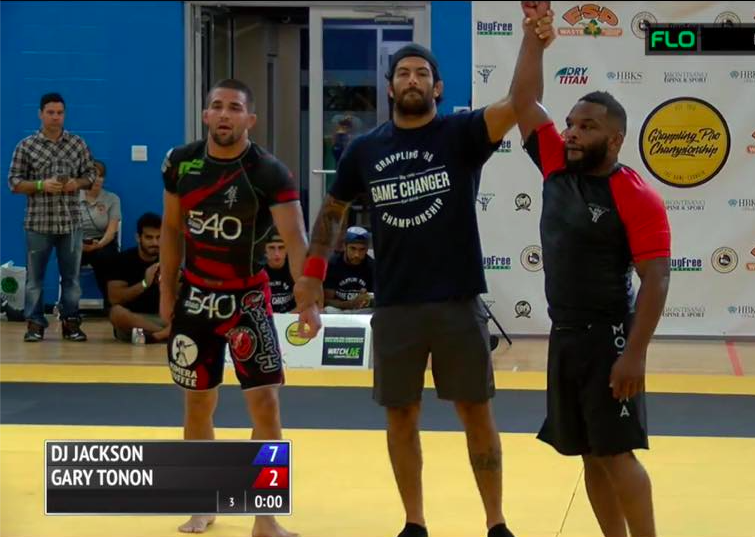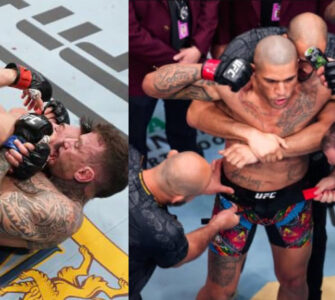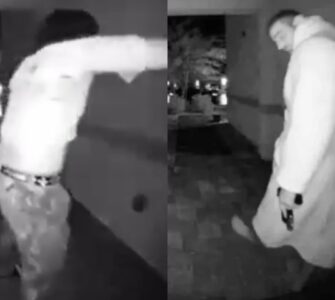Photo: Flograppling.com
There is some division in the grappling world about whether point-based or submission-only style tournaments are a better format for ‘true’ jiu-jitsu, fairer competitions, or better entertainment. The Grapplers Pro Championships, held September 18 in Naples, Florida, offered a new flavor to points-based scoring system. ( Grapplers Pro Rules ). The new rules are designed to spread the art of grappling, build a larger audience for the sport, as well as be a format to showcase the skills of talented competitors, which are all notable endeavors.
While this author did not attend the tournament, I was able to view the pro division showcased live online. Despite the many talented athletes participating in the welterweight pro division, I regretfully did not find the event to be a game changer – in fact, the opposite. If anything, it brought out some of the weaker elements of professional grappling including confusing rules, poor officiating, as well as clearly enabling strategies that may prevent interesting action or submissions in key matches.
Here are some of the things I noted as problem areas:
Challenges – At times, referees would stop the action for long periods to have conferences amongst a ridiculous number of officials about a particular score. It was unclear if these were literal challenges from a coach, or merely the referee team in disagreement with itself. This was odd for a few reasons. Firstly, there was already a three-referee system in place, which one would think would be more than enough referees per match to come to a consensus. Secondly, these meetings on the mat included as many as eight or more officials with even competitors providing input into the resolution. Additionally, these rules conferences gave rest periods to both competitors during matches and literally changed momentum. The most glaring episode was during the DJ Jackson/Garry Tonon match, but there were several other instances. Additionally, I saw competitors having between-round conversations with officials, lobbying their perspectives and arguing calls, which does not create an enviable environment for fair competition. I wholeheartedly disagree with one of the announcers who stated he liked the long official reviews, claiming that having them ‘takes away from a lot of the confusion’ – actually, it’s clear evidence of confusion. If the rules are unclear to the officials, then I can’t imagine how competitors, coaches, announcers, and especially spectators have a chance to understand the action.
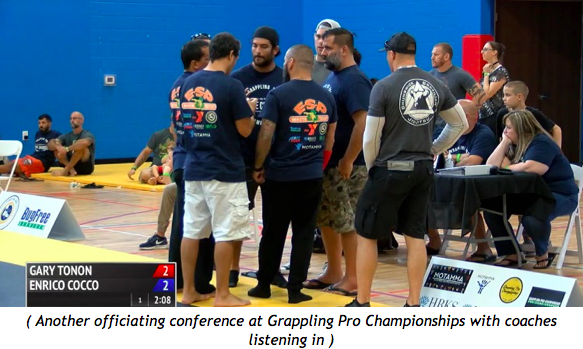
Takedowns – One of the hallmarks of traditional point-based tournaments is control. This is typically a three second period right after a scoring action or position that reinforces that it is a point-worthy activity. Instead, these rules encourage scoring by simply pushing opponents out of bounds, or worse, doing full takedowns out of bounds without the need for control. The reason I say ‘worse’ is that to encourage competitors to take the action off the mats towards barriers and the hardwood floor seems to create an unsafe environment that should be discouraged. This would appear to be borrowed more from Sumo wrestling than traditional submission grappling, and I found it awkward at best. Takedowns out of bounds without control were continually a source of the ‘challenges’ that needed to be resolved during matches.
Tie Breaker and Lead System rules – I’ve heard these rules suggested often and never understood the desire for them conceptually. In the event of a tie at the end of a round, the competitor that scored last receives an additional point. While this is a theoretic incentive to score last, it also builds in an incentive to stall to achieve the last score. Additionally, scoring during the round to tie the match is given an additional point. Personally, this is confusing as their written example illustrates, plus I hate seeing additional points awarded for strategy rather than actual action. Clearly the motivation is to prevent ties during the matches and avoid referee’s decisions, which are stated only occur ‘when there are no points scored throughout all round(s)’. But I think this notion that the last person to score deserves a point does not provide the motivation or effect they intended.
New Rules – Creating unique rules is perfectly fine, but as I drone on about many times, using a one-pager to encompass all the possible scenarios that can be encountered in the dynamic art of grappling just opens the door for various interpretations and confusion. There just simply isn’t enough solid information provided in writing to draw from to prevent on-the-spot calls and provide consistency. I believe this also is the source of many referee discussions during the matches.
Rounds – Perhaps as an homage to MMA, the pro division had three to five rounds of five minutes each. I felt this broke up the action too much, and permitted strategies that slowed down the progress of the matches even more. Often, longer length grappling matches between comparable athletes are a war of attrition, so giving fighters a periodic rest did not help give the better conditioned athletes the advantage they rightfully deserve to press the action and finish the match.
Stalling – Unfortunately, I see no provision or parameters defined for stalling as a penalty. If it is a penalty, I saw clear stalling/passivity that was never called. This means that strategies utilizing being the last to score, or scoring during the round to tie can be reinforced literally by inactivity. This seems counterintuitive if you’re trying to encourage action and submissions.
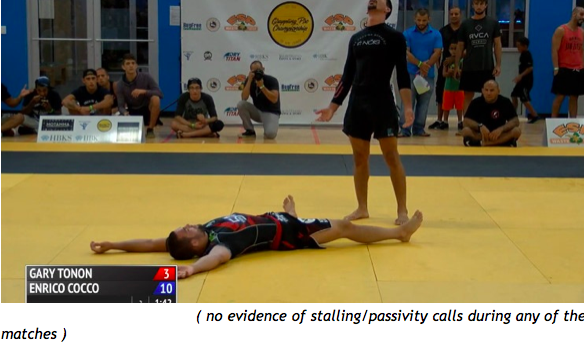
Injuries – Five minute rest times for an injured athlete to recover are not uncommon. But these rules permit a competitor to injure his opponent with an illegal move and only receive a warning. The only risk to the offending competitor is that his injured opponent will not be able to continue and be declared the winner. This is a clear incentive, specifically in a finals match, for an injured competitor to definitely ‘not be able to continue’ and automatically be declared the winner. Additionally, it might permit competitors to intentionally hurt game opponents with illegal techniques merely to gain an advantage against them. In summary, this is bad business and either not carefully thought through or articulated well in written form.
Scoring differences – Obvious changes included 2 points for reversals and 3 points for controlling turtle position. Of course in traditional points formats, reversals are non-scoring actions, and controlling turtle may only result in an advantage ( for those formats that score them ) or 2 points when used for completing takedowns or sweeps. It’s unclear from the written rules whether this new format means to include sweeps in reversals, as well as to make them a compound score, such that a takedown or sweep that finishes in turtle position receives both 2 points for the takedown and 3 points for the turtle control for a 5 point technique.
Referee Team – I have no specific knowledge of the referee staff, and I sympathize with this first run of a new rules format. This being said, I saw no consistency in gestures or scoring, I saw no one take a lead role in conflict resolution, and the body language and continual challenging created an aura of uncertainty. An officiating staff must inspire confidence to everyone watching, and unfortunately, I did not recognize a high level of confidence.
Unanswered Questions – Can takedowns be performed from the knees? Is three seconds of control a requirement for a full score? What happens when a locked submission goes out of bounds? Is slamming with intent to injure permissible? In the event of a tie, what criteria are used to determine a referee’s decision? This is a short list of the many questions that are not present in the current written rules. Considering the prize money, understanding these and other obvious questions will minimize debates when deciding matches.
So here’s where I provide some caveats to my observations. This is a new rules format that is a pretty substantial departure from existing ones, so applause for trying something new. With big money on the line, tensions can get high, and that can create some challenging circumstances for any officiating team. There’s no question that with new rules comes some confusion, so there is a certain amount of slack that the event deserves for the learning curve. Also, there were some exciting matches with quality submissions, so the event was by no means boring or uninteresting.
But in my opinion, outcome determines success. Rules and officiating are the backbone to tournaments, and the flow of the matches is directly related to the action the format is driving. I think back to the last ADCC where some champions won without scoring a point, and many highly anticipated matches provided long, boring stand up battles with little or no action, and certainly nothing resembling submissions. This event offered similar eye sores.
While many are quick to assume that inactive matches are always the result of evenly matched competitors, I contend that it is the rules format that is critical to driving behavior in competition. Time limits, rest periods, penalties, allowable techniques, point or advantage scores, and tie resolutions all are factors in driving how competitors behave while strategizing for victory. Regrettably, most of the results of the Grappling Pro Championships rest on the new rules format.
So although I give credit to this particular tournament for having the guts to partially reinvent traditional point scoring events, I didn’t witness that this new format offered any departure from existing tournaments, or successfully created the action fans would want to watch. Until they can devise a more detailed set of rules and work out the many issues I’ve highlighted in this article, I don’t see this as a format that will catch on or provide great promise to propel grappling forward. And unfortunately, that was their stated goal.
About the Author. David ‘Silverfox‘ Karchmer is a 1st Degree black belt in Brazilian Jiu Jitsu and has been training for more than 16 years. David’s martial arts background spans over two decades, and includes a black belt in Tae Kwon Do he received in 1993. His BJJ journey began at Gracie Thornwood, NY in 1999 after he took a seminar with Royce Gracie and knew he was hooked on the art. In addition to training and instructing, David has focused the last eight years on officiating grappling competitions and has officiated more than 3000 gi and no-gi matches at over 60 events for multiple organizations. He is a previous head referee at Grapplers Quest and the current head referee at FIVE Grappling, and routinely officiates events in North America. Visit his officiating website www.TheGrapplingReferee.com .

